Schools
Argentina
Buenos Aires
The capital of Argentina and the Paris of South America, Buenos Aires is one of the world’s great cities. Our language center is located in the heart of the city in the fashionable Recoleta neighborhood. This upper-middle class area is famous for its cafes, restaurants and bars. The Recoleta cemetery is the last resting place of many of Argentina’s most famous citizens, including Eva Peron. The school is a classic turn of the century building that has been remodeled into the perfect place to learn Spanish. With small classrooms, meeting areas, library, media room, rooftop patios and old world charm, students have everything they need in one place. If you only visit one South American city in your lifetime, make it Buenos Aires.
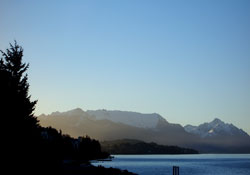 Bariloche
Bariloche
Known as the skiing capital of South America, San Carlos de Bariloche is an outdoor enthusiast’s dream. The ski season goes from June through September, so it is the perfect place for all of those northern hemisphere skiers who can’t get enough bright white powder during the summer. Located along the shores of Lake Nahuel Huapi in the Patagonian Andes the setting is absolutely stunning. There is plenty to do for non-skiers from white water rafting to boat trips, fishing, climbing and trekking. It is also the center for South American chocolate productions. Our campus is located just five blocks from the center of town. It has a large meeting area, small classes and patio. Most of the lodging options, which include host families and apartments, are within 10 minutes’ walk from the school.
Return to top
Chile
Santiago
This modern cosmopolitan Capital of Chile is one the great cities of South America. Located in the central part of the country, this city of 5 million is situated at 1600 feet above sea level, at the base of the great snow covered Andes. Skyscrapers dominate the main commercial district while other parts of the city are more reminiscent of 19th century Europe. City life in Santiago is a vibrant mixture of bustling markets, packed cafes, interesting museums, shopping and a night life that does not quit. Santiago is also a great location for students who love outdoor activities. Because of its central location, skiing, surfing and wine tasting are all conveniently close by. Our Spanish school is located in the residential neighborhood of Providencia. This is a quiet section of the city, but is still close to all the attractions Santiago has to offer.
Return to top
Costa Rica
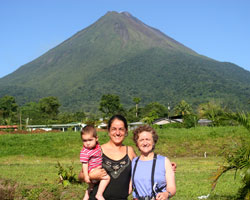 Arenal (La Fortuna)
Arenal (La Fortuna)
The town of La Fortuna has 10,000 inhabitants and is in the north central region of Costa Rica. Just to the north is the world famous Arenal Volcano, hot springs and lake. This is a great destination for those seeking a place to be immersed in the language and culture of Costa Rica, but at the same time have a great vacation. Because of its location it has so many different things to do and see, from the famous volcano and hot springs, to wind surfing, spelunking, hiking, sailing, horseback riding, zip lining, rafting and much more. It is the home of our Medical Program and our Nursing Spanish Program which is accredited by the State of California for continuing education nursing units.
Heredia (Santo Domingo)
Located in the foothills of the Central Valley, Santo Domingo de Heredia is a small colonial town just 20 minutes from downtown San Jose. This location combines the best aspects of the small rural town feel with the big city and all that goes with that. During the day and after classes you can walk to the center of town and feel like one of the community and hang out and have coffee near the central park. At night you can take a cab into San Jose and visit the many casinos, restaurants, night clubs and bars. There are also many different museums and theaters to visit, as well. Our brand new facilities are modern and our apartment option is a great lodging alternative to host families.
Monteverde
Located at the top of a mountain 6000 ft above sea level in the tropical cloud forest, Monteverde is famous for its nature preserves and cheese. People come from all over the world to walk along the trails of the Monteverde preserve. There is a community of Quakers that has lived and farmed on the mountain since the mid 1950’s and they make great cheese. We have a 5.5 hour group program that is very popular and allows students to take more classes without taking up all of their afternoons. Volunteer opportunities are abundant, especially for those that want to work with nature and the environment.
Playa Dominical
This sleepy little beach town located off the beaten track on the central Pacific coast is in the tropical rainforest with stunning beaches and great surfing. The campus is a five minute walk to the beach, situated along the Rio Baru. Across the river is the Hacienda Baru Nature Preserve that has over 1000 acres of protected rainforest. It is not unusual to see toucans in the trees at the school and monkeys along the preserve’s paths. The Medical Spanish Program offers students and professionals an opportunity to work with rural patients and clinics. If you ever wanted to try surfing or are already an expert, this is the best beach break in all of Costa Rica.
Playa Manuel Antonio
The most famous beach resort in Costa Rica and its oldest, is a lively town of about 8,000 with fun night life and a great national park of the same name. In the National Park is the south facing beach Manuel Antonio. This was once rated as one of the top five beaches in the world by National Geographic. Even though the park is small area wise, it is still filled with abundant wildlife and is a great place to relax and study after classes. The campus of the school is located on a cliff overlooking the Pacific with beautiful views up and down the coast. The town of Quepos, where the host families are located is a bustling sea port just north of the resort town.
Playa Tamarindo
Our only beach campus located in the tropical dry forest, Playa Tamarindo is on the northern Pacific coast with long white sandy beaches and the most sunny days of the year. This section of Costa Rica is considered to be the Gold Coast because even during the heart of the rainy season, it still gets less rain than anywhere else. Beach activities abound with opportunities for snorkeling, scuba diving and surfing. The culture of the region is also slightly different as it was once part of Nicaragua in the 1800’s and more closely resembles the hacienda lifestyle of the north. The campus of the school is located just 1½ blocks from the beach and is easy walking distance to everywhere in town. Classes are held in our new open air school building, next to our student apartments.
San Jose (San Pedro)
San Jose is the capital of Costa Rica and San Pedro is one of its nicest suburbs. Located just two miles east of downtown, near the University of Costa Rica, it is a lively and fun neighborhood. This campus is for those students who want to be in a big city, as San Jose is the only big one in the country. There are great museums, restaurants, theaters and clubs. It is the heart of the political system and a city on the go. Because it is located right smack dab in the middle of the country geographically, it is easy to get to anywhere in the country by public transportation. The school facilities are the most extensive in the country with a computer lab, business center and restaurant.
Turrialba
Our most immersive location is this mountain valley town of 35,000 people. Located 1½ hours from San Jose, Turrialba is a safe and beautiful location with only Spanish speakers in the area. This is a great place for families with children of all ages. Our Kindergarten program is the only one of its kind in Central America for children 2 to 7 years old. This is also the location where our Medical Program is affiliated with the local government hospital. We have a medical clinic at the school, which is located on the grounds of the tropical research center CATIE. This is a 2000 acre preserve with rivers, lakes, primary forests and botanical gardens. All of which are accessible to our students.
Return to top
Ecuador
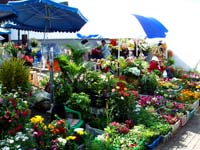 Cuenca
Cuenca
The City Cuenca is the cultural capital of Ecuador and its third largest city. It is also Ecuador’s best-kept secret. Cuenca and its surrounding region are rich in history, with a colonial atmosphere that has survived thanks to years of almost complete isolation. Cuenca is a city of fascinating contrasts: two universities, museums and art galleries stand alongside Indian markets rarely visited by foreigners. Our Spanish language school in Cuenca is located in a 300 year old brick building, walking distance to the central plaza and Cathedral.
Quito
Quito is the capital city of Ecuador. Our Spanish language school is in the modern section of Quito with a number of different parks, plazas, restaurants, bars and discos all within a few minutes walk. The staff is very professional and courteous and can help students plan different weekend excursions. Group activities such as parties, excursions, sporting events, dance and cooking classes take place every week and are organized by the school. Ecuador is an amazingly diverse country with a great deal to see and experience and Quito is its political and economic heart.
Return to top
Mexico
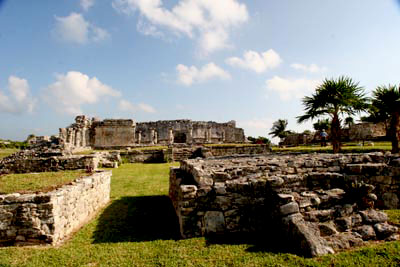 Cuernavaca
Cuernavaca
The “City of Eternal Springtime” has a great year round climate with a very mild rainy season. There are close to 700,000 residents, so it is not a small city, but the historic center feels that way. The nightlife is fun and energetic and the area around the city is filled with fantastic tour opportunities. This idyllic setting is only an hour's bus ride from Mexico City and the international airport, but is a world apart from the hustle and bustle of the big city. Our Spanish institute is located in this rich cultural and historical setting. We have been teaching Spanish here for almost three decades. Students can utilize the many different facilities and programs offered at the school such as the library, auditorium, cafeteria, telephone, fax, e-mail and postal services.
Guanajuato
The city of Guanajuato is located in the central part of Mexico. This is a “World Heritage Site” and one of the most beautiful cities in Mexico. It is a small and quaint Colonial town with superb architecture, narrow winding cobblestone streets and quite possibly the most impressive central plaza in the entire country. Because this is a university town, the night life is fun and eclectic. There are plenty of restaurants, bars and discothèques, many of which stay open into the wee hours of the morning. Our campus is located on a quiet street near the center of town. We have 10 classrooms, a multimedia room and a beautiful patio with open terrace. Our teachers are all degreed Mexican natives that have been specially trained to teach Spanish as a second language.
Oaxaca
The capital of the state of the same name, Oaxaca is a UNESCO certified Patrimony of Humanity city. This is the most diverse city in all of Mexico with more than 15 ethnic groups that make up the population. Each of theses cultures is present in the architecture and history of the region. The historic center and the Monte Alban archaeological center are just two of the many examples of these different cultural influences. Oaxaca is also famous for its food and festivals. Christmas, All Saints Day, Constitution Day, Workers Day, Easter and New Years are just some of the many fiestas that mark the Oaxacan calendar. The greatest celebration of the year is Guelaguetza, which takes place the first two Mondays following July 16th.
Playa del Carmen
This once small fishing village has become a very popular destination on the Yucatan Peninsula of Mexico. It is a wonderful place to visit for those that are looking for white sandy beaches and crystal blue water. More relaxed and culturally significant than nearby Cancun, Playa del Carmen is easily reached by the international airport that services both destinations. A short ferry ride across the straits to the island of Cozumel and you are diving or snorkeling in one of the worlds most beautiful coral reefs. Our Spanish language institute is located in the center of town, just minutes by foot to the beach. We have air-conditioned classrooms, access to wireless internet and a private courtyard where students can relax during breaks.
Return to top
Panama
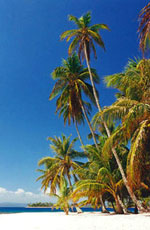 Bocas del Toro
Bocas del Toro
Our Spanish center is located on the main island of the Bocas del Toro archipelago on the northeastern coast of Panama. Bocas has just recently been discovered by international tourists but still retains its typical Caribbean architecture and relaxed, slow pace. Because of its location in one of the most untouched and beautiful regions of Central America, there are a number of unique options from which to choose. The PADI dive program allows students to become certified scuba divers or advance their ability with any of the other programs PADI offers, including Dive Master. For students not interested in scuba diving, the school has a variety of excursion options available, that combine outdoor activities with introduction to the local culture.
Boquete
Our language center is located in the valley of Boquete, famous for its coffee, wildlife and natural beauty, in the western highlands of Panama at 1,200 meters (3,600 ft.). Nestled among the country’s most mountainous region, this peaceful town is situated between the Caldera River, which lies to the east, and the Baru Volcano to its west. Boquete enjoys a sunny, cool mountain climate, comfortable year round and considered nearly perfect. Boquete is also known as the “Valley of the Flowers and the Eternal Spring.” This highly lush land is home to the Ngöbe Bugle indigenous and is also considered the Ecotourism capital of Panama. The untouched tropical cloud forests surrounding Boquete are home to an immense variety of flora and fauna.
Panama City (El Dorado)
Panama is situated on the land bridge between North and South America. Our center is located in the midst of the country’s capital, Panama City, in one of its best residential neighborhoods, El Dorado. It is near to the downtown areas, the large Metropolitan National Park and not far from the Panama Canal, truly one of the modern wonders of the world. The city is also one of the most important financial and commercial centers in the world with a dynamic and bustling business community. This is a cosmopolitan city of skyscrapers which has one of the most multiethnic and culturally diverse populations in the world. It is an incredible place to visit and get to know the people as well as a being a great jumping off point to many of the country’s natural wonders.
Return to top
Peru
Cusco
The Old Capital of the Incas is a dynamic and culturally significant city. It has a population of 300,000, but retains the intimate feel of a smaller town. The Plaza de las Armas is a beautiful central Plaza with Spanish Colonial buildings and churches surrounding a large open area and fountain. Many of the festivals throughout the year take place in this plaza with parades and religious processions. Because of its wealth of Incan remains and the amazing colonial buildings, Cusco has been named a World Heritage site by UNESCO. Cusco is also the doorway to Machu Picchu, the “Lost City of the Incas.” Students can walk the Inca Trail or they can take the train to the base of the ruins at Aguas Caliente. Either way you will visit the most significant archeological site in all of South America. Our Spanish school is in the middle of all of this and allows students to get to know this wonderful and amazing city in the Andes.
Lima
The Capital of Peru is a large South American city with over 8 million residents. It was founded by the conquistador Francisco Pizarro in the mid-16th century as a major hub for trade because it lies on the Pacific Ocean and was easily accessible to the rest of the New World. Lima became very wealthy from its trade in gold and silver that was mined in the Andes Mountains. Because of this the Historic Center of the city is filled with some of the most magnificent examples of colonial architecture in all of Latin America. It has been designated a World Heritage site and is a Peruvian national treasure. Our Spanish school is located in the wealthy beach front neighborhood of Miraflores. The campus is on a quiet street near many shops restaurants, bars and night clubs. Lima has a great night life as well as all the modern conveniences you would expect from a cosmopolitan city.
Return to top
Spain
Alcalá de Henares (Suburban Madrid)
Alcalá de Henares is one of Spain’s oldest university cities located within the Community of Madrid, 25 minutes from the center of the Capital City, 15 minutes from Barajas International Airport. Our language center is located near the lovely “Casco Historico” that is frequently used for television and film shoots that take advantage of its many well preserved buildings and patios, and convenient proximity to Madrid. Spain is home to more UNESCO “World Heritage Sites” than anywhere else on the planet and Alcalá de Henares is one of them. The birthplace of Cervantes, Spain’s greatest writer, it is the best way to attend a school in Madrid, without having to live in the big city.
Almeria (Coastal Andalusia)
Located on the southern Mediterranean coast, Almeria is a bustling provincial capital with fantastic weather, great beaches and amazing Moorish history. Our campus is located in the heart of the city, surrounded by the historical and cultural areas of the city and only a 10 minute walk to the beach. Overlooking the town is the Alcazaba, the old Arabic fortress that dates back almost 1000 years. Just east of town along the coast is the Cabo de Gata National Park with plenty of hiking trails, sandy beaches and beautiful vistas. There are also plenty of water sports, including; sailing, scuba diving and wind surfing. Because Almeria is the sunniest province in Spain, you can be outdoors all year round.
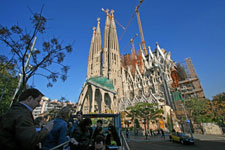 Barcelona (Catalonia, Mediterranean coast)
Barcelona (Catalonia, Mediterranean coast)
Called the “Jewel in the Crown of the Mediterranean,” and rightly so, Barcelona is truly a remarkable city. Acting as a bridge between “Classic Spain” and the rest of Europe it is a culturally dynamic and vibrant town. It is the second largest city in Spain and fiercely independent. Nowhere is this more evident than in the unique and colorful architecture of the “modernista” movement typified by Antonio Gaudi. His most famous structure, the Sagrada Familia cathedral is not even finished. They have been working on this for over 100 years and they still have a ways to go. With amazing night life, an historically significant gothic quarter and sun drenched beaches, it is hart to beat this as a travel destination.
Granada (Andalusia)
Our language center is located in the Andalucian city of Granada, situated right in the heart of the city in the old Moorish quarter of Albaicin. The school offers small classes and a great deal of cultural programs with over 40 different activities from which to choose. Granada is world famous for its incomparable and remarkable Alhambra. This amazing citadel sits atop one of the city’s hills and was the last bastion of Moorish civilization on the Iberian Peninsula. Students can spend many days and hours exploring the many different gardens, buildings and palaces. Granada is also one of the main university towns in Spain and the school has a very international student body.
Madrid (City Central)
The Capital City of Spain is a lively metropolis of over 3 million people. It is the geographical, political and cultural heart of the country. It has been the capital since it was founded in 1652 and has become the melting pot of the Latin world with people from all parts of Spain and the Americas. The Puerto del Sol is the center of town right next to the Plaza Mayor. It is an area surrounded by small winding streets, shopping, great places to eat, bars and nightclubs. On New Year’s Eve it is the equivalent of Time Square in New York. Madrid boasts grand monuments and incredible museums, highlighted by the Museo del Prado, one of the worlds most famous and should not be missed.
Málaga (Coastal Andalusia)
Our language center in Málaga is located on 3 floors of a newly restored building near the beach. This location offers students the chance to combine Spanish language studies with an unforgettable vacation on the Mediterranean Sea. Cool breezes and a relaxed atmosphere will refresh you after study sessions. You can enjoy sunny terraces, sandy beaches and warm temperatures while you practice Spanish in Andalusia. We feature intensive and effective courses, extra-curricular activities, excursions to Sevilla and Granada and of course we are only 50 m. from the beach. Also, the Malaga airport is the main international arrival destination in southern Spain.
Pamplona
The capital of the province of Navarra, Pamplona is located in the foothills of the Pyrenees Mountains in the north of Spain. This vibrant city of 250,000 was founded by the Roman General Pompey in the first century BC. There are numerous historical as well as archeological sites to visit in and around the town. The old center of the city is a fantastic warren of winding streets, impressive plazas, monuments, gardens and parks. Famous for the “Running of the Bulls” each July, Pamplona the rest of the year is our most immersive location. Students who are serious about learning the language and culture of Spain can do no better than Pamplona. Our Spanish immersion center is in a 19th century building near the old medieval walls and adjacent to a network of beautiful parks and gardens.
Puerto de Santa Maria (Cadiz, southern Atlantic coast)
Our language center was established in 1986 in El Puerto de Santa Maria. El Puerto, as it is called by locals, is a city of a hundred palaces and also the home of Christopher Columbus. A city full of history, yet young enough to have plenty of activities ranging from day time amusement parks, to night long discos. Its beautiful, long, golden sandy beaches on their own guarantee a wonderful time, in fact there are more than 22 km of beaches in El Puerto de Santa Maria. Nearby is the city of Cadiz, which is easy to visit using the many ferries that travel back and forth across the bay.
Salamanca (Castilla/Leon, central Spain)
Our school in Salamanca has the advantage of being a modern, fully equipped center right in the heart of all the charm and ambience of Spain’s Golden City. Salamanca is famous as Spain’s oldest university town and still buzzes with students and student life by day and night. From here one can easily make excursions over into Portugal and the other historic cities of old Castilla. The Plaza Mayor is the best example of its kind of Spain’s love affair with the large central plazas and pedestrian ways. This is one of the few towns in Spain that can boast of two cathedrals. The 12th century Old Cathedral is a classic example of Romanesque architecture while the New Cathedral, started in the 16th century is all Gothic.
San Sebastian (Basque Country, north Atlantic coast)
Few cities can offer so many alternatives in one single area: marvelous scenery, beaches, mountains, folklore, remarkable customs and traditions, important musical and cinematic events—Jazz Festival, Film Festival, Music Fortnight—as well as countless parties, “Semana Grande,” Carnival, “aldereros” (Tinker’s festival), San Sebastian’s Day…as well as having internationally recognized cuisine. The school is located in a central area, easy walking distance to all parts of downtown and the beach. Students can learn in small groups or in private lessons. The program and the teachers are top notch and the service is excellent. Another advantage is that it is only 12 miles from the French boarder, so it is easy to make day trips to France.
Seville (Andalusia)
Situated on the banks of the Guadalquivir River, Seville is the capital of Andalusia and southern Spain. The home to the Catholic Monarchs, Ferdinand and Isabella, during the last stages of the Reconquista, no other Spanish city has more historical significance. Dating back almost three thousand years, every significant Mediterranean culture has controlled this vital trading center. From the Phoenicians, Greeks, Carthaginians, Romans, Moors and Visigoths, all the way to modern Spaniards, Seville’s cultural and economic importance has been understood. Add to this fantastic architecture, beautiful gardens and squares, lively night live, flamenco dancing and a zest for life and you have one of the best places in the world to learn Spanish.
Valencia (Mediterranean coast)
Spain is a country full of historically significant cities and Valencia is no exception. One of the oldest continuously inhabited towns in Spain, it was founded over 2000 years ago by retired Roman legionnaires. The large cathedral in the center of the medieval part of the city houses what some believe to be the Holy Grail. Long overlooked by international travelers, Valencia has made a dramatic comeback. As signs of this resurgence are the newly completed City of Arts and Sciences and the hosting of the America’s Cup sailing race to be held in 2007. Miles and miles of white sandy Mediterranean beaches stretch out north and south of the city. It is also justifiable famous for its night life, which does not usually get started until after midnight.
Return to top
|
